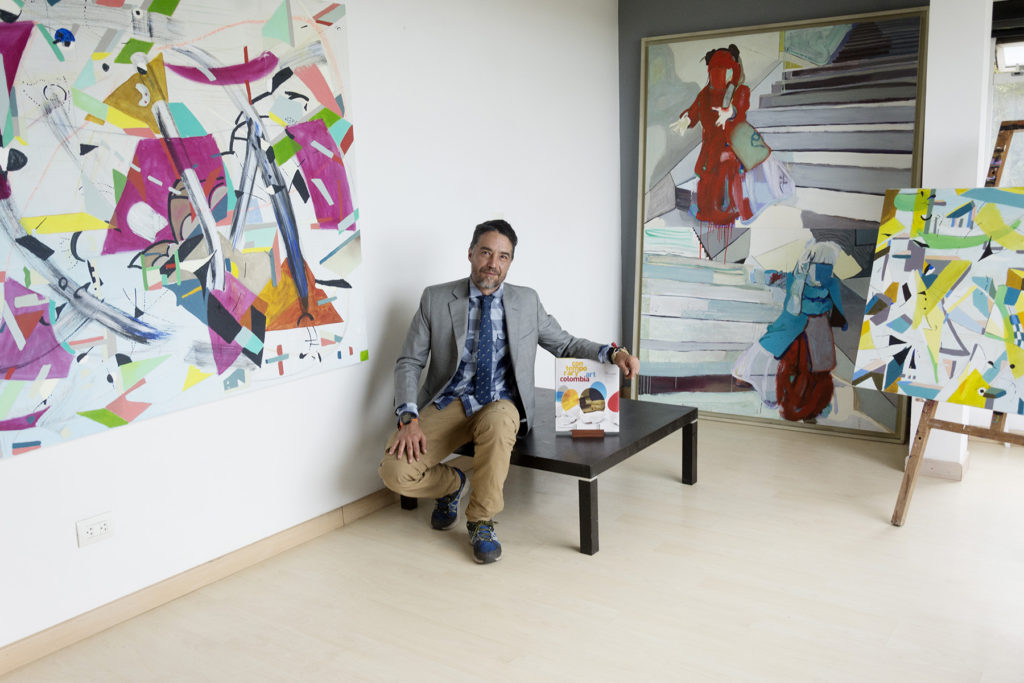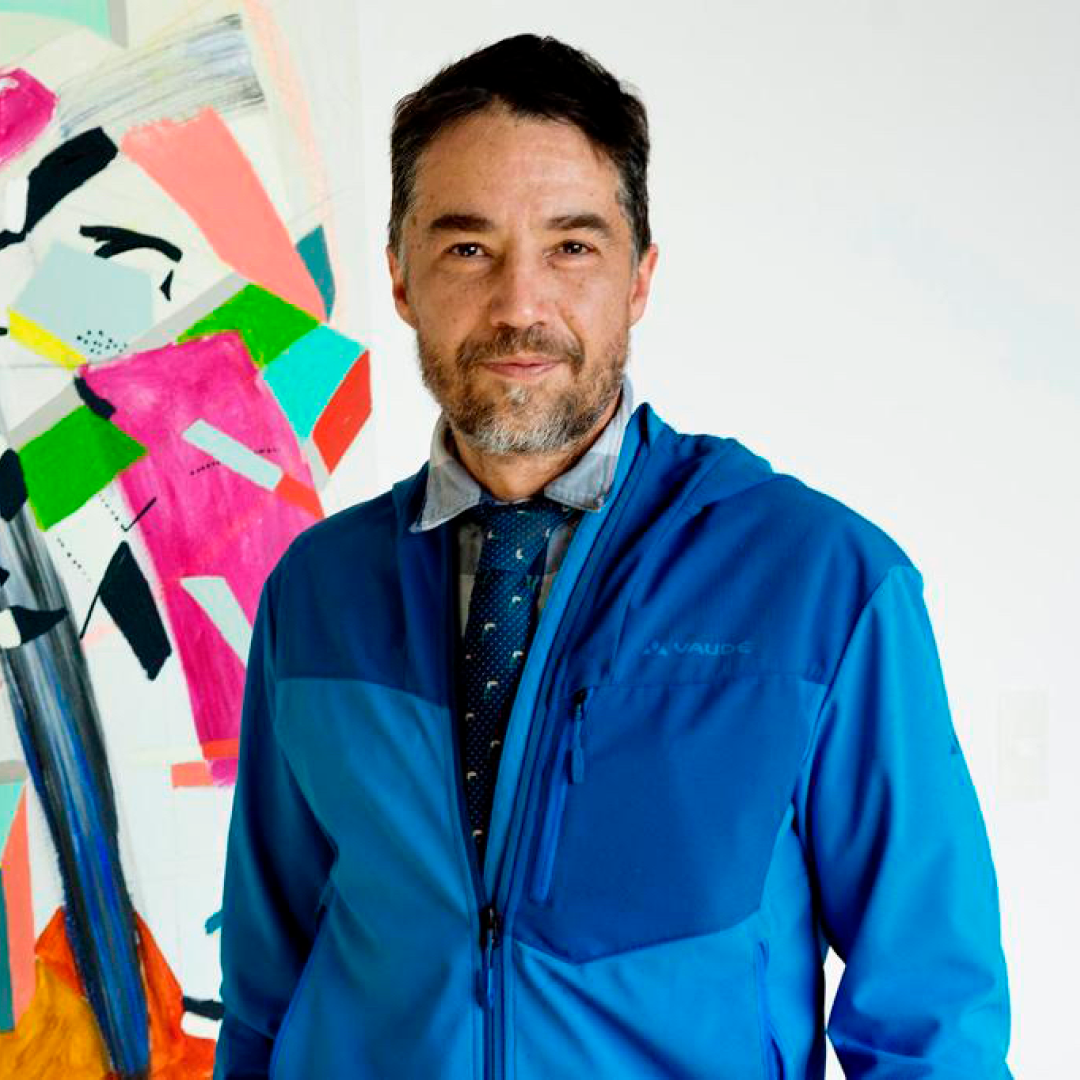Fine Art Shippers discussed with Christopher Paschall his journey in the art world, his insights on Colombian art, and his perspectives on the international art fairs he knows so well from the inside.
How did you get started in the art world?
Christopher Paschall: Oh, it’s a long story. I grew up in the United States, but I often say I’m from three cities: New Orleans, Bogotá, and Paris. One of my uncles is a renowned Colombian painter who lives in Paris. During my childhood and teenage years, whenever I visited France, I spent time in the studios of his artist friends. I saw how some artists chose to spend their last cents on paints and canvases rather than food. This made me appreciate not only the beauty of art but also its power to shape lives.
Later, I pursued a degree in business administration. My professional life began in Latin America, where I worked for three major corporations over a decade: Alpina, a leading Colombian multinational, Exxon (later ExxonMobil) in the oil industry, and EMI Music. Throughout my corporate career, I spent my earnings on art. I wanted my home filled with unique, valuable pieces.
Eventually, I left the corporate world, and the question became: what industry would allow me to engage with the most influential and culturally significant people—the top 1%? The answer was clear: art. In the late 1990s, I began organizing art exhibitions. These were underground events in artists’ studios and in my own home. But I wanted to test myself—not just as someone who loves and appreciates art but as someone who could sell it. My early exhibitions went well, and in 2003, I curated my first major show in a gallery a friend lent me. It featured a renowned Colombian-French graffiti artist and marked the start of my career as an art dealer and gallerist. Soon after, I opened my first gallery in Bogota.
What happened next? How was your journey unfolding?
Since then, it’s been an incredible adventure. My goal was always to take local talent to a global stage. My gallery was among the first in Colombia to participate in international art fairs—by now, I think we’ve taken part in over a hundred. Over time, I’ve grown beyond the traditional role of a gallerist. Now, I also produce events, festivals, and collaborations that bring together multiple art forms—music, literature, architecture, and visual arts.
How do you see your mission as a gallerist?
For the past 24 years, I've run my gallery under different names, always specializing in contemporary Latin American art. I've lived in Colombia for 33 years, and during this time, I've worked to place many contemporary artists in major collections and museums. My role is more than just selling art—I support artists and help them advance their careers.
Each step on an artist's career ladder is as challenging as the one before. I often say that selling art for under $10,000 is something almost anyone can do, but it’s after that benchmark that a career truly begins to take shape. From there, the milestones grow: $50,000, $500,000, over a million, and even into the multi-million-dollar range. Each step demands just as much effort, if not more, than the one before.
How do you select the artists for your gallery? Is your choice based on narratives, visual style, or something else?
In modern art, the focus was heavily on craftsmanship—about 90% technique and 10% concept. The artworks were often visually understandable, but even when they weren’t, the skill behind them was undeniable. In conceptual art, the balance shifted to 90% concept and 10% technique. Contemporary art is somewhat balanced—50% technique and 50% concept. At the same time, the observer plays an important role in contemporary art, as it is a dialogue between the artists and the audience.
I have a deep appreciation for craftsmanship and technique. For me, an artist’s work has to “wow” the viewer—it has to be incredible, beautiful, and impactful. Without that, it’s not for my gallery. I specialize in painting, which I consider the queen of all art forms. Painting has shaped history and culture and, to this day, is the hardest art form to master. And let’s not forget—paintings remain the most valuable works of art in the world, both culturally and monetarily.
Could you name a few artists you have represented and who have grown with your gallery?
I would say, I’ve grown with the celebrated artists I’ve had the privilege to work with: Ana Mercedes Hoyos, Alvaro Barrios, Nadin Ospina, Gustavo Vejarano, Fernando Arias.
As for the artists I have helped find their way in the art world, I’m proud to have been working with Sair García, Carolina Convers, Alejandro Ospina, Joel Grossman, Rodrigo Echeverri, Rafael Gómezbarros, Eduard Moreno, Miler Lagos, Ramón Giovanni, Camilo Matiz, Chanoir, as well as the rising stars Jerónimo Villa and Juan Pablo Mier.

What distinguishes Colombian art from other parts of the world? How would you characterize it?
As I think about Colombian art, I’m always struck by how deeply it embodies the soul of Colombia—its jungles, oceans, and the Amazonian and Pacific essence. Take Carlos Jacanamijoy, for instance. He’s a master of color and oil paints, depicting the jungle and the ocean in a way that feels both abstract and figurative. When you look at his work, it’s like you are transported into the very heart of these landscapes.
Sair Garcia takes a political and conceptual approach. He paints rivers, homes, and the struggles of our people, often using unconventional materials like stainless steel or even crude oil His work is both disturbing and beautiful.
Rafael Gómezbarros, with his iconic ant installations reflecting on migration, has made waves globally. Then there’s Miler Lagos, whose fusion of physics and art challenges perceptions. Federico Ovalles, a Colombian-Venezuelan artist, brings a geometric, conceptual approach, repurposing found materials like coffee jute bags to comment on territory and division.
I could go on and on. Colombia is a true creative powerhouse, not just for art but also for music, composition, and film. It’s an honor to live among artists who transform the richness of our land and culture into extraordinary works.
This year, you participated in the Scope art show in Miami with the Federico Ovalles show. Could you share some impressions and observations?
Scope was the first contemporary international art fair I participated in. My first encounter with Scope was when it was a satellite art fair in a hotel building in New York. I fell in love with Scope's pioneering spirit—they were trailblazers in creating satellite art fairs, long before anyone else. Back then, you only had the big names like Armory, FIAC, and Art Basel. For seven years, I stepped away from Scope to focus on my own festival in Colombia, Barcú (Bogota Art and Culture). Held in a historical district, it attracts 30,000 visitors annually with an incredible mix of art, culture, and festivities. After the pandemic, I decided to return to the art fair scene, and again I started with Scope.
This is my third Scope in Miami since my comeback, and it’s been the best one yet. They’ve made significant changes, bringing in new directors, curators, and a fresh approach to how they hang and curate the galleries. I was very impressed by this step-up in quality. It’s clear they’re making a strong statement about staying a major independent player in the art world.
Could you tell us more about your festival?
The festival started in 2013 and ran until 2019, pausing due to the pandemic. It was set in Bogota’s historic colonial district. The program was organized in twelve houses, each with its own vibe and experience. Over six days, we transformed the streets with 25 bands playing across the festival, four each night. Remarkably, 17 of those bands went on to perform at Glastonbury because of this event. We also featured 20 to 25 galleries, cultural villages, and a mix of invited artists. Unlike art fairs, which are very often ego-driven, this was a place for a true human connection and celebration of art.
After selling the festival just before the pandemic, I began working on a new project in Bogotá—Quinta Fest, which I aim to transform into a globally renowned art and culture event. And I will make it happen, mark my words!
What other dreams do you have?
My goal is to return to the United States. I’ve always told my artists: why swim in a pond when you can swim in the ocean? The effort is the same, but the ocean offers far greater opportunities. Now, it’s time for me to take my own advice. Returning to the U.S. feels like the right move. I’m ready to explore the opportunities the ocean has to offer.
Interview by Inna Logunova
Photo courtesy of Christopher Paschall
